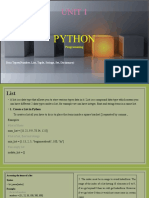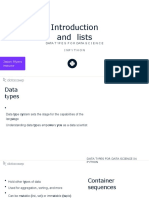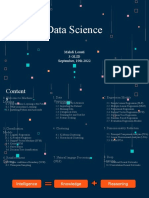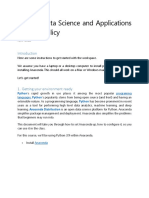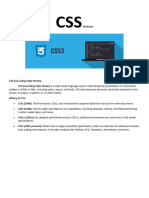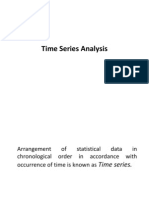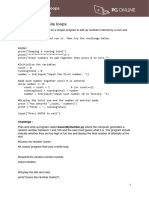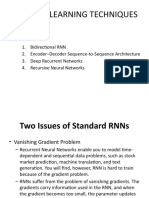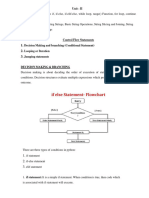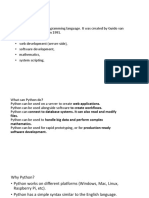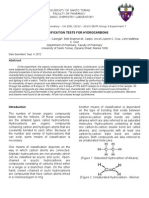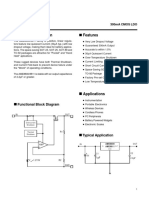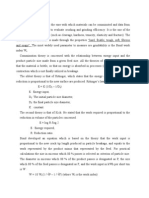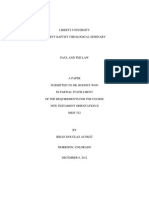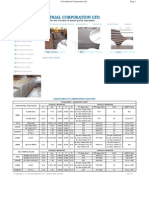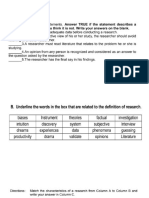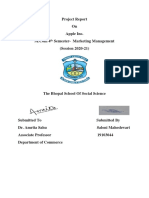Must Learn
Python
Functions
For Data Professionals
� *Disclaimer*
Everyone learns uniquely
What matters is your ability to understand
and write Python Functions efficiently.
This Doc will help you with the same.
1
�1. NumPy - numpy.array()
About:
Syntax:
numpy.array(object, dtype=None, copy=True, order='K', subok=False, ndmin=0)
Example:
import numpy as np
# Create a NumPy array from a Python list
my_list = [1, 2, 3, 4, 5]
my_array = np.array(my_list)
print(my_array) # Output: [1 2 3 4 5]
2
�Practice Questions:
3
�2. Pandas - pandas.DataFrame()
About:
Syntax:
pandas.DataFrame(data=None, index=None, columns=None)
Example:
import pandas as pd
# Create a DataFrame from a dictionary
data = {'Name': ['John', 'Alice', 'Bob'], 'Age': [25, 28, 32]}
df = pd.DataFrame(data)
print(df)
Name Age
0 John 25
1 Alice 28
2 Bob 32
4
�Practice Questions:
5
�3. Matplotlib -
matplotlib.pyplot.plot()
About:
Syntax:
matplotlib.pyplot.plot(x, y, format_string='', **kwargs)
Example:
import matplotlib.pyplot as plt
# Plot a line chart
x = [1, 2, 3, 4, 5]
y = [10, 5, 7, 8, 2]
plt.plot(x, y, marker='o')
plt.xlabel('X-axis')
plt.ylabel('Y-axis')
plt.title('Line Chart')
plt.grid(True)
plt.show()
6
�Practice Questions:
7
�4. Seaborn - seaborn.heatmap()
About:
Syntax:
seaborn.heatmap(data, vmin=None, vmax=None, cmap=None, center=None,
robust=False, annot=None, fmt='.2g', annot_kws=None)
Example:
import seaborn as sns
import matplotlib.pyplot as plt
import numpy as np
# Create a heatmap
data = np.random.rand(3, 3)
sns.heatmap(data, annot=True, cmap='YlGnBu')
plt.xlabel('X-axis')
plt.ylabel('Y-axis')
plt.title('Heatmap')
plt.show()
8
�Practice Questions:
9
�5. Scikit-learn -
sklearn.model_selection.train_test_split()
About:
Syntax:
sklearn.model_selection.train_test_split(*arrays, test_size=None,
train_size=None, random_state=None)
Example:
from sklearn.model_selection import train_test_split
import numpy as np
# Split a dataset into training and testing sets
X = np.arange(10).reshape((5, 2))
y = range(5)
X_train, X_test, y_train, y_test = train_test_split(X, y, test_size=0.2,
random_state=42)
print(X_train)
print(X_test)
10
�Practice Questions:
11
�6. Statsmodels -
statsmodels.api.OLS()
About:
Syntax:
statsmodels.api.OLS(endog, exog=None, missing='none', hasconst=None)
Example:
import statsmodels.api as sm
import numpy as np
# Fit a linear regression model
X = np.array([1, 2, 3, 4, 5])
y = np.array([5, 7, 9, 11, 13])
X = sm.add_constant(X) # Add a constant column for the intercept
model = sm.OLS(y, X)
results = model.fit()
print(results.summary())
12
�Practice Questions:
13
�7. TensorFlow -
tensorflow.keras.models.Sequential()
About:
Syntax:
tensorflow.keras.models.Sequential(layers=None, name=None)
Example:
import tensorflow as tf
# Create a sequential model
model = tf.keras.models.Sequential()
model.add(tf.keras.layers.Dense(64, activation='relu', input_shape=(10,)))
model.add(tf.keras.layers.Dense(64, activation='relu'))
model.add(tf.keras.layers.Dense(1, activation='sigmoid'))
print(model.summary())
14
�Practice Questions:
15
�8. PyTorch - torch.nn.Linear()
About:
Syntax:
torch.nn.Linear(in_features, out_features, bias=True)
Example:
import torch
# Create a linear layer
layer = torch.nn.Linear(10, 5)
print(layer)
16
�Practice Questions:
17
�9. Datetime -
datetime.datetime.now()
About:
Syntax:
datetime.datetime.now(tz=None)
Example:
import datetime
# Get the current date and time
now = datetime.datetime.now()
print(now)
18
�Practice Questions:
19
�10. Math - math.sqrt()
About:
Syntax:
math.sqrt(x)
Example:
import math
# Calculate the square root of a number
result = math.sqrt(16)
print(result)
20
�Practice Questions:
21
�11. Random - random.choice()
About:
Syntax:
random.choice(seq)
Example:
import random
# Choose a random element from a list
fruits = ['apple', 'banana', 'orange', 'grape']
random_fruit = random.choice(fruits)
print(random_fruit)
22
�Practice Questions:
23
�12. CSV - csv.reader()
About:
Syntax:
csv.reader(csvfile, dialect='excel', **fmtparams)
Example:
import csv
# Read a CSV file
with open('data.csv', 'r') as file:
reader = csv.reader(file)
for row in reader:
print(row)
24
�Practice Questions:
25
�13. OS - os.listdir()
About:
Syntax:
os.listdir(path='.')
Example:
import os
# List files in a directory
files = os.listdir('path/to/directory')
print(files)
26
�Practice Questions:
27
�Here are some sample datasets that you can
use for the practice questions:
#� Practice Question
Sample Dataset:
import numpy as np
import matplotlib.pyplot as plt
# Generate random x and y values
np.random.seed(0)
x = np.random.rand(100)
y = np.random.rand(100)
# Scatter plot
plt.scatter(x, y)
plt.xlabel('X-axis')
plt.ylabel('Y-axis')
plt.title('Scatter Plot')
plt.show()
28
��� Practice Question
Sample Dataset:
import numpy as np
import matplotlib.pyplot as plt
# Generate x values
x = np.linspace(0, 10, 100)
# Generate y values for three lines
y1 = np.sin(x)
y2 = np.cos(x)
y3 = np.tan(x)
# Plot multiple lines
plt.plot(x, y1, color='red', marker='o', label='sin(x)')
plt.plot(x, y2, color='blue', marker='s', label='cos(x)')
plt.plot(x, y3, color='green', marker='^', label='tan(x)')
plt.xlabel('X-axis')
plt.ylabel('Y-axis')
plt.title('Multiple Lines Plot')
plt.legend()
plt.show()
29
�� Practice Question
Sample Dataset:
import pandas as pd
import numpy as np
import seaborn as sns
import matplotlib.pyplot as plt
# Create a DataFrame
data = {'A': np.random.rand(100),
'B': np.random.rand(100),
'C': np.random.rand(100)}
df = pd.DataFrame(data)
# Generate the correlation matrix
corr_matrix = df.corr()
# Plot the correlation matrix as a heatmap
sns.heatmap(corr_matrix, annot=True)
plt.xlabel('Columns')
plt.ylabel('Columns')
plt.title('Correlation Heatmap')
plt.show()
30
� Practice Question
Sample Dataset:
import numpy as np
from sklearn.model_selection import train_test_split
# Generate sample data
X = np.random.rand(100, 3) # Features
y = np.random.randint(0, 2, 100) # Labels (binary)
# Split the data into training and testing sets
X_train, X_test, y_train, y_test = train_test_split(X, y, test_size=0.3,
random_state=42)
31
� Why
Bosscoder?
750+ Alumni placed at Top
Product-based companies.
More than 136% hike for every
2 out of 3 working professional.
Average package of 24LPA.
Explore More



